|
MONTEZUMA CASTLE
Montezuma Castle Archeology - Part 2: Textiles |

|
SANDALS
(Nos. 25, 27, 28, 29, 30, 31, 32, 45, 50, 51)
The 10 sandals and their ties are all made from yucca leaves or fibers,22 with two exceptions: No. 45 is of Agave parryi; and the instep cord of No. 27 is cotton.
22. All four species of yucca are used. Classification shows:
Yucca mohavensis—Nos. 28, 29, 30, 51
Y. elata—Nos. 31. 32, 27
Y. baccata—No. 50 and heel tie of No. 45
Y. macrocarpa—No. 25
Six of them (Nos. 28, 29, 30, 31, 32 and 50) are made from whole yucca leaves in the following manner: four leaves are folded to make eight strands. The folds are at the toe of the sandal, and the strands are braided from the toe to within 2 inches of the heel, with an over-one under-one movement (plain plaiting; see drawing, p. 46). The last 4-inch section at the heel is turned up on the sandal sole and fastened with yucca fiber, to form a heel pad. The toe straps for these sandals are of yucca leaves, partly shredded. They enter the weave at the front of the sandal, enclosing the second and third toes, cross one, and re-enter the weave at either side of the heel. Sometimes there is a heel cord of an extra length of yucca fiber attached to the toe straps just before they enter the weave at the heel.
One heel fragment of a sandal (No. 51) made from shredded yucca leaves, is braided as those just described.
These simple sandals are not shaped to fit the foot; the toes are squared or only slightly rounded. Similar ones are described in the Sierra Ancha finds, although they are generally an over-two under-two braid (twill plaiting). Haury calls them Pueblo III products (pp. 64-65, Pl. XLI, b; Hough, p. 83; BAEB 65, type 1, a, 1, p. 101; Mera, p. 55).
One sandal (No. 25, p. 49) is braided with the same over-one under-one movement, but with 6 yucca fiber cords, folded at the toe to make 12 strands. An extra cord binds the sandal sides. The toe strap for this is a three-strand braid of small yucca fiber cords, fastened in the weave at heel and toe. The heel strap is missing.
No. 45 (p. 51) is made from fibers of Agave parryi. It is a braid of 27 strands. (Cf. Haury, p. 65.) The braiding follows an over-two under-two movement (twill plaiting). The heel and toe are so frayed that it is impossible to determine how they were finished. The sandal broadens at the toe, which was evidently notched. The toe strap is of two 11-strand cord braids, originating from a woven section over the toe, and passing along each side of the foot to enter the weave at the heel. The heel strap is a separate cord arrangement of Yucca baccata. Haury places sandals like this in the Pueblo IV period.
The cords used for the last two sandals described are composed of bundles of fibers bound spirally with a few single fibers to keep them compact.
There is one sandal which is made by wickerwork (No. 27, p. 52). Here yucca fiber cords are woven hack and forth over six tightly twisted, two-strand yucca warps. This sandal is round-toed and shaped to fit the foot. The toe and heel cords are of yucca string, and the instep cord of cotton. There is a description in Hough (p. 84) of a sandal like this, with four rather than six warps. (Cf. BAEB 65, type II, a, p. 103, and Baldwin, 1938, p. 466.)
There is no dye or coloring applied to any of the sandals. It will be seen that they vary in shade, but the shading is doubtless due to weathering and dirt ground into the specimens.

|
| Figure 19 |
Specimen 28. Sandal with Frayed Toe (PS No. 41)
Maximum length: 9-1/4"; 23.5 cm.
Maximum width: 2-3/4"; 7 cm. Heel, instep and ball. Amount turned under for heel pad: 2-1/2"; 6.4 cm.
Toe straps: Longest section left measures 9-1/4"; 23.5 cm.
Heel strap: Doubled, 4-1/2"; 11.4 cm.
Material: Natural colored leaves of Yucca mohavensis. (Yucca leaf toe straps.) Shades from light sole, M&P 11-J-7, to dark top, M&P 16-A-12.
Weave: Same as in specimen No. 30, p. 46. Method of attaching toe straps at heel, see specimen No. 29, below. Heel strap attachment is looped over the toe straps and tied with a square knot.

|
| Figure 20 |
Specimen 29. Sandal (in two parts)
Maximum length: Section a (toe): 4"; 10.2 cm. Section b (heel): 4"; 10.2 cm. Probably ca. 8" to 8-1/2" long.
Maximum width: Section a: toe and ball: 2-1/2"; 6.4 cm. Section b: at heel 2-3/8"; 6 cm. at instep; 2-1/8"; 5.5 cm. Amount turned up for heel pad: 3-1/4"; 8.3 cm.
Tie: Entirely separate from sandal. Entire length of tie: 20"; 50.8 cm. Impossible to see exactly how it was joined at toe.
Material: Natural colored leaves of Yucca mohavensis. (Yucca fiber strips for straps.) Shades from light sole, M&P 4-A-9, to dark upper, M&P 7-A-12.
Weave: Same as specimen No. 30, p. 46. Different attachment of heel and heel pad, and then split; each half passes over opposite sides of the heel pad and down through the braid at the sandal edges; then up again and forward, to become the toe strap.
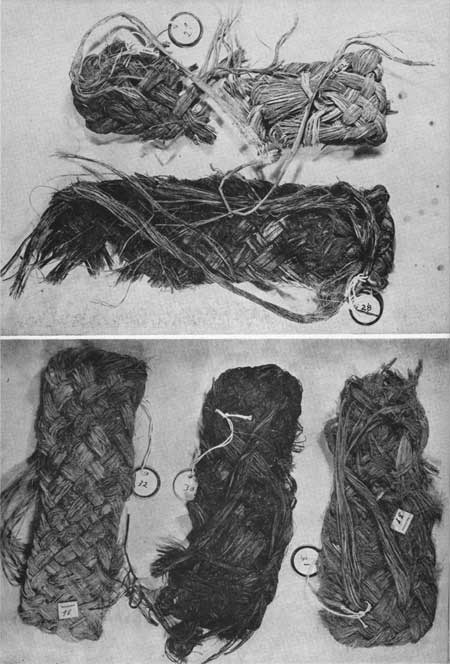
|
| Plate 31. Sandals, Speciments Nos. 28, 29, 30, 31, 32 |
Specimen 30. Sandal
Maximum length: 7-3/4"; 19.8 cm.
Maximum width: 2-3/4"; 7 cm. Width at heel: 2-3/4"; 7 cm. Width' at instep: 2-3/4"; 7 cm. Width at ball: 2-3/4"; 7 cm. Width at toe: 2-1/2"; 6.3 cm.
Amount turned up for heel pad: 3-1/2"; 8.9 cm.
Length of straps: Toe (each), from point where it enters weave at the toe to point where it enters weave at heel: 7"; 17.8 cm. Heel, from knot to knot: 6"; 15.2 cm. (See drawing.)
Material: Yucca mohavensis. Straps: yucca fiber strips. Shades from light tan sole, M&P 11-I-5, to dark upper, M&P 15-L-12.
Weave: (see drawing) (Cf. Hough, p. 83; BAEB 65, p. 101, type I, a, 1; Haury, pp. 64-68, pl. XLI, a and b; Guernsey, pp. 66-67, Fig. 24; Roberts, p. 516.) Over-one under-one braiding, such as is used here, is apparently rare. Over-two under-two braiding is more frequently described.

|
| Figure 21. Over-one under-one braiding |

|
| Fig. 22. Top of sandal, showing method of attaching heel tie (a) and toe tie (b). Specimen 30. |
Specimen 31. Sandal (PS No. 39)
Maximum length: 7-3/4"; 19.7 cm.
Maximum width: 3-1/4"; 8.3 cm. Width at heel: 2-1/4"; 5.7 cm. Width at instep: 2-3/4"; 7 cm. Width at ball: 3-1/4"; 8.3 cm. Width at toe: 3"; 7.6 cm.
Amount turned up for heel pad: 3-1/4"; 8.3 cm.
Length of straps (each): Toe strap, from point where it enters weave at toe to point where it enters weave at heel: 6-3/4"; 17.2 cm.
Material: Natural colored leaves of Yucca elata. (Yucca fiber strips for straps.) Shades from light sole, M&P 10-G-2, to dark top, M&P 15-L-12.
Weave: Same as specimen No. 30 (p. 46). No heel strap. One loose end of the square knot of the toe straps at the heel is drawn back through the weave to the sole of the sandal.
Specimen 32. Sandal (PS No. 40)
Maximum length: 8-1/4"; 21 cm.
Maximum width: 3"; 7.6 cm.
Width at heel: 2-1/2"; 6.4 cm. Width at instep: 2-3/8"; 6 cm. Width at ball: 2-7/8"; 7.4 cm. Width at toe: 3"; 7.6 cm.
Amount turned up for heel pad: 3"; 7.6 cm.
Length of straps (each): Toe straps, from the knot at the toe to point of attachment at heel: 10-1/4"; 26 cm. Heel straps: missing.
Material: Natural colored leaves of Yucca elata. (Yucca fiber straps.) Shades from light sole, M&P 12-H-2, to dark top, M&P 15-A-i 2.
Weave: Same as in specimen No. 30 (p. 46), with two exceptions: 1. Lack of heel strap. 2. Toe straps tie differently at toe. Each strap passes through the weave at the toe to the under side of the foot, then back up through a hole more to the front of the foot. They tie on top of the sandal in a square knot. They tie at the heel as in specimen No. 30 (p. 46).

|
| Figure 23 |
Specimen 50. Sandal
Maximum length: 7-1/8"; 18.1 cm.
Maximum width: 3"; 7.6 cm. Width at heel: 3"; 7.6 cm. Width at instep: 2-3/8"; 6 cm. Width at ball: 3"; 7.6 cm. Width at toe: 2-1/2"; 6.4 cm.
Amount turned up for heel pad: 3"; 7.6 cm.
Length of heel strap (doubled): 5-1/2"; 14 cm.
Length of toe strap (each): From point of entrance in weave at heel to point of entrance in weave at toe: 7-1/2 "; 19.1 cm.
Material: Yucca baccata leaves. Shades from light sole, M&P 12-B-6, to dark upper, M&P 15-A-12.
Weave: (Cf. specimen No. 30, p. 46, drawings and references.)

|
| Figure 24 |
Specimen 51. Sandal Fragment
Maximum length: 4"; 10.2 cm.
Maximum width: 3"; 7.6cm.
Material: Yucca mohavensis. Color M&P 12-A-6.
Weave: Heel section and pad of sandal woven as specimen No. 50 (above).
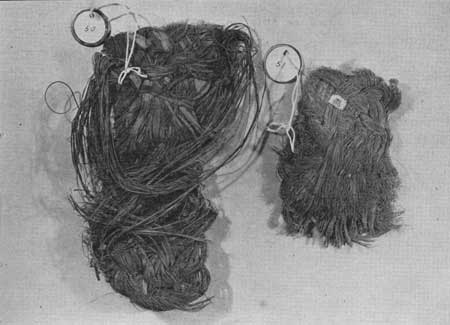
|
| Plate 32. Sandals, Specimens No. 50, 51 |
Specimen 25. Sandal (PS No. 8)
Maximum length: 9-3/4"; 24.8 cm.
Maximum width: 3-1/4"; 8.3 cm. Width at heel: 3"; 7.8 cm. Width at ball: 2-3/4"; 7 cm. Width at toe: 31/4": 8.3 cm.
Length of braided tie: From point of attachment to weave in toe to point of attachment to weave in heel. 8-1/2"; 12.7 cm.
Material: Yucca macrocarpa, some natural colored, some stained. Shades from light sole, M&P 4-A-8, to dark top, M&P 15-A-12.
Weave: Sandal, composed of yucca fibers bunched to form cords; these fibers are bound by a few strips of yucca fiber twisted over them at irregular intervals. The technique of the sandal braiding is like that of Specimen No. 30 (p. 46), except that there are six strands used. Also an extra strand (or cord of yucca fibers) is bound down each side of the sandal. The tie is a three-strand braid of yucca fibers: It is caught into the weave at the toe on top of the sandal (the section called "toe" appears to have a double thickness, which might indicate it to be the heel, but the strap arrangement seems more logical if it he designated toe") and into the weave under the heel: A piece of braid attached to it before it passes beneath the foot at the heel to enter the weave seems to be a remainder of a heel strap. After entering the heel weave about one-half inch from the sandal's edge, the braid passes through the weave and loops over the edge of the sandal, back through the same hole, and loops over the sandel edge again, this time in the center of the heel. Then it passes under the sandal and up through the weave about one-half inch from the opposite side of the sandal, loops around that edge, back through the same hole, and is then broken off. It might have been part of the heel strap arrangement, or might have be come the second toe strap. (See illustration).
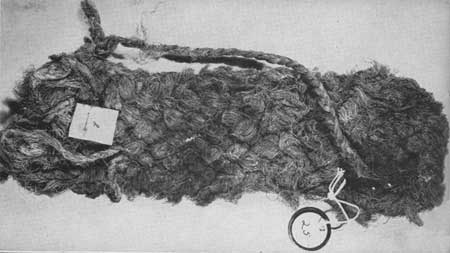
|
| Plate 33. Sandal, Specimen No. 25 |

|
| Figure 25 |

|
| Figure 26. |
Specimen 45. Sandal (PS No: 161)
Maximum length: 8-1/2"; 20.5 cm.
Maximum width: 3-3/4"; 9.6 cm: Width at heel: 2-3/4"; 7 cm. Width at instep: 3"; 7.7 cm: Width at ball: 3-3/4"; 9.6 cm. Width at toe: 3-1/2"; 9 cm. Length of toe strap: Braided. From point of entrance in weave at heel to point of entrance in weave at toe: 6"; 15.3 cm:
Material: Agave parryi in sandal. Fiber bundles, bound spirally with other fibers. Heel tie of Yucca baccata. The toe strap is a braid of small bundles of fibers. The heel strap is two bundles of fiber twisted loosely.
Weave: The sandal is an over-two under-two braid of 27 fiber bundles. The heel and toe sections are so frayed that it is impossible to analyze how they are finished. The heel and toe strap arrangements can be seen in the technical drawings. (Cf. Haury, pp. 65-66, Pl. XLII, b, c, and d; and p. 67, Fig. 12, a.)
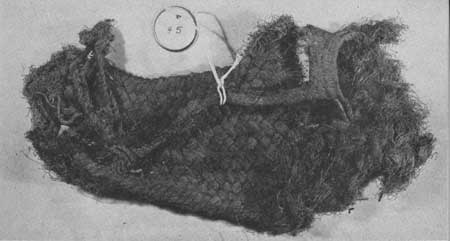
|
| Plate 34. Sandal, Specimen No. 45 |

|
| Figure 27. Detail of braid, Sandal, No. 45 |
Specimen 27. Sandal. (PS No. 159)
Maximum length: 8-3/4"; 22.4 cm.
Maximum width: 2-1/2"; 6.4 cm. Width at heel: 2"; 5.1 cm. Width at instep: 2-1/8"; 5.4 cm. Width at ball: 2-3/8"; 6.1 cm. Width at toe: 2-1/2"; 6.4 cm.
Toe straps: Section A (see Fig. 28): Length from point of entrance into weave to point of knotting, 2-3/8"; 6.1 cm. for No. 1; 2"; 5.1 cm. for No. 2. Average width of strands: .2 cm.; composed of two elements twisted together.
Section B (see Fig. 28): Length, knot to knot, 3"; 7.6 cm. Consists of a large cotton cord composed of two smaller cords twisted together. Each of the smaller cords is made of eight slender strings of cotton twisted.
Material: Sandal, Yucca elata. Section A, cord, Yucca elata. Section B, cord, cotton. Color ranges from light sole, M&P 4-E-7, to dark upper, M&P 6-A-11.
Weave: Wicker work, six warps of very tightly twisted yucca fibers. Twisted yucca cords woven over these (see drawing p. 55). The heel cord is missing, but the toe cord attachment is shown in Fig. 28. (Cf. Hough, p. 84; BAEB 65, Type II, a, p. 103. Baldwin, 1938, p. 466.)
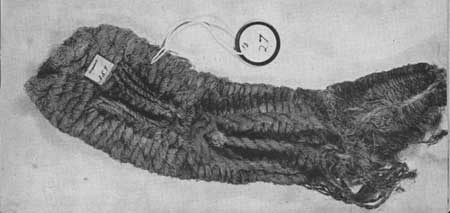
|
| Plate 35. Sandal, Specimen No. 27 |

|
| Figure 28. Specimen No. 27, showing toe and heel tie attachment |

|
| Figure 29. Weave of sandal, No. 27 |
| <<< Previous | <<< Contents>>> | Next >>> |
wnpa/tech/3-2/sec2.htm
Last Updated: 04-Mar-2008
Western National Parks Association